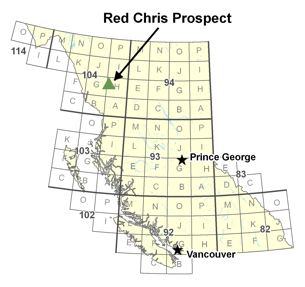Summary
 The Late Triassic Red Chris porphyry Cu-Au prospect in northern British Columbia hosted in supracrustal rocks of the Mesozoic Stikine Terrane represents an important emerging mineral exploration property in northern British Columbia. We are undertaking a collaborative MDRU-Imperial Metals-Geoscience BC project to examine what we consider to be the preserved upper parts of an alkalic porphyry Cu-Au deposit, which extends, based upon recent exploration, to as much as 1-km below the present surface.
The Late Triassic Red Chris porphyry Cu-Au prospect in northern British Columbia hosted in supracrustal rocks of the Mesozoic Stikine Terrane represents an important emerging mineral exploration property in northern British Columbia. We are undertaking a collaborative MDRU-Imperial Metals-Geoscience BC project to examine what we consider to be the preserved upper parts of an alkalic porphyry Cu-Au deposit, which extends, based upon recent exploration, to as much as 1-km below the present surface.Porphyry Cu-Au deposits result from multiple and successive vein formation events whose mineralogy (sulfide and alteration) reflect the hydrothermal fluid chemistry, flow paths, and the pressure-temperature conditions during formation. The distribution of the mineralization products defines the hypogene ore, controls the economics of a porphyry Cu deposit, and also affects the oxidation during weathering. The zoning is accompanied by different mineral assemblages, which reflect the hydrothermal fluid chemistry and evolution of those fluids as well as depth within the porphyry environment. Understanding the distribution of the alteration assemblage, their relationship to veins and rock types, and origin is important to any 4-D model of a deposit, and is a major goal of the project. Their relative timing provides the 4th dimension. Understanding the core of the porphyry is important to the parallel study of the geochemical dispersion halo around the deposit.
Graduate student research will characterize the evolution of the Main and East Zone porphyry deposit with the intention of building an evolutionary model of the deposit. Specific questions important to building a 4-D model for the Cu-Au porphyry deposits include evolution of the hydrothermal system, structural setting, and the vertical and lateral development of the hydrothermal system. Activities and techniques to be used include mapping of the deposit along sections through the re-logging of core holes, structural analysis of vein geometry, mineral chemistry, and alteration mineralogy. Two sections constructed using drill core across the Main and East deposits will constrain the research. The distribution of alteration and evolution in time will be the principal theme to be addressed. Senior research staff will also evaluate the down-hole multi-element geochemistry in the context of the SWIR mineral chemistry, and provide this input to the graduate project.
In addition to defining the distribution and sequencing of alteration, 3 aspects of the deposit will be examined in detail, in addition to building the geometric distribution of rocks and alteration assemblages.
- Carbonate minerals: Baker et al. (1997) have previously defined a sequence of carbonate mineral deposition. As a routine part of the alteration study, the project will examine through the mineral chemistry as well as the carbon and oxygen isotopes the origin of the carbonate minerals, to address the question of fluid sources and why so much carbonate is found within the deposit.
- Rutile chemistry:, Rutile in alkalic porphyry deposits has been shown to vary in chemical composition, with vanadium substituting for titanium, at the Northparkes deposit (Scott, 2005). A systematic study has never been completed on a BC alkalic deposit, and the Red Chris deposit, in view of the deep drilling, offers an opportunity to develop the mineral as a potential vector toward ore as well as during regional exploration geochemistry in vegetated terranes.
- Structural geometry: Quartz veins generally form systematic networks in porphyry deposits (Tosdal and Richards, 2001), and as such can be used to gain some degree of control on the post-mineral deformation of any deposit. As most of the BC porphyry deposits are tilted to some degree (Sketchley et al., 1995), placing constraints on the Red Chris system will aid in the resource delineation, and subsequent exploration in the district.